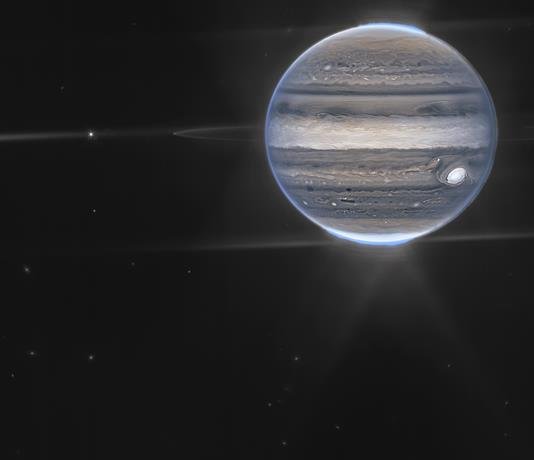The James Webb Space Telescope (JWST) has provided two new, astonishingly precise images of Jupiter, showing its giant storms and intense winds and giving scientists more clues about life on the planet.
The US space agency (NASA) celebrated the quality of the details this Monday, according to Imke de Pater, professor emeritus at the University of California and associate director of observations. They are not expected to be “that good”.
The published photographs help us see that the auroras extend high above Jupiter’s north and south poles. These images come from a near-infrared camera (NIRcam) with three infrared filters.
what Infrared light is invisible to the human eyeThat light is mapped to the visible spectrum. Longer wavelengths appear red and shorter wavelengths appear blue.
In these snapshots, the “Great Red Spot” is clearly visible, a sandstorm that according to NASA is very large. “It can swallow up the earth”, This time appears white because it reflects more sunlight.
A scientist on the web, Heidi Hammel, points out in the report that the brightness is a sign of high altitude, so this large area has “high altitude fog.”
In the images you can also see Jupiter’s rings, “A million times fainter than the planet”, By reference, the two smaller moons are Amalthea and Atrasthea.
Researchers have already begun to analyze the data obtained, which does not come to Earth in an orderly package, but must be translated into images.
These last two were processed by Judy Schmidt, who collaborated with Ricardo Hueso on one of the planet’s small satellite displays, whose research at the University of the Basque Country deals with the study of planetary atmospheres.
The James Webb Space Telescope is a joint mission of the European (ESA) and Canadian (CSA) and NASA. It was released in December last year.
It is the largest ever sent into space, provides an unprecedented view of the universe at infrared and mid-infrared wavelengths, and will make it possible to study a wide range of celestial objects, from neighboring galaxies. Distant regions of the universe.
New images of Jupiter obtained by @nasaweb The planet’s features stand out, including its turbulent Great Red Spot (shown here in white). These images were processed by citizen scientist Judy Schmidt: https://t.co/vSqRtj3ajy pic.twitter.com/ULAoS295kB
– NASA in Spanish (@NASA_es) August 22, 2022


:quality(85)/cloudfront-us-east-1.images.arcpublishing.com/infobae/SMPW7M5BQFERBOQUPJXKCOKARY.jpg)
:quality(85)/cloudfront-us-east-1.images.arcpublishing.com/infobae/NP5NEZXMZFGNLBHNEQJHPJVMKM.jpg)

:quality(85)/cloudfront-us-east-1.images.arcpublishing.com/infobae/X7DZAL3I4REJTKPZ4Y4DYBHFMI.jpg)